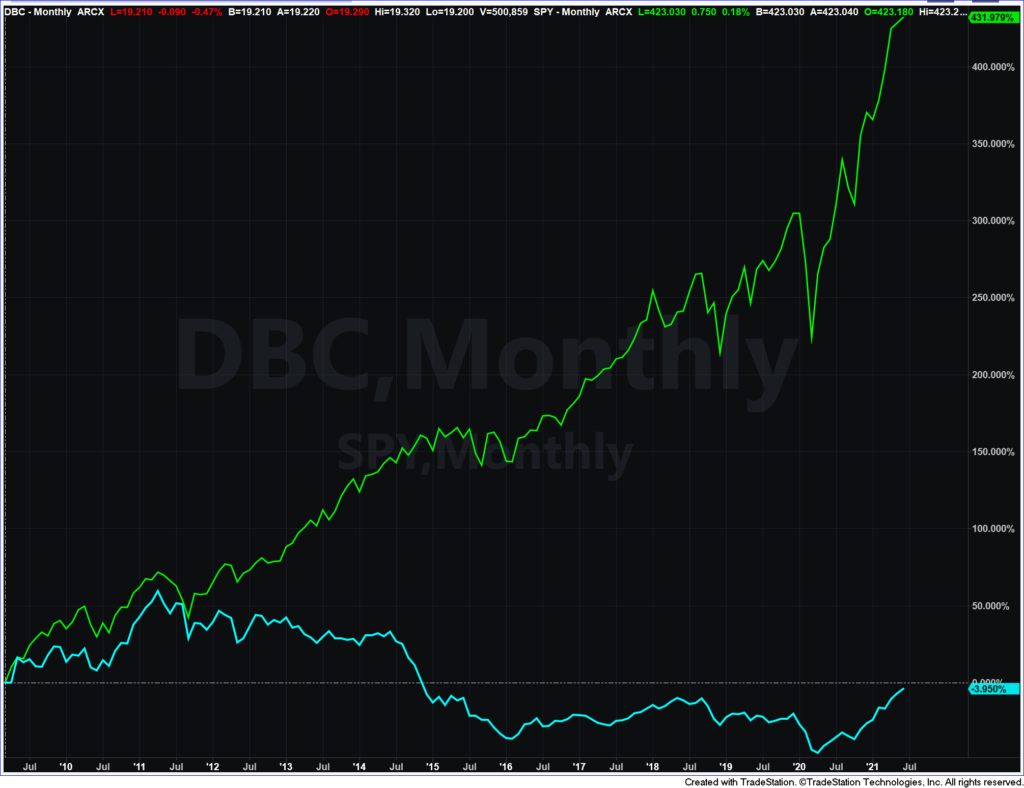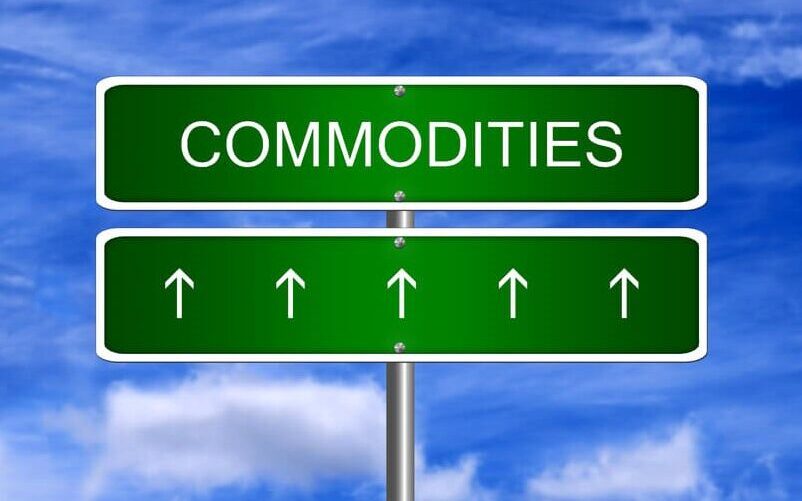Year-to-date, the Nasdaq 100 is up about 7% … the S&P 500 and Dow Jones Industrial Average are up 13% … and the small-cap Russell 2000 has gained nearly 19%.
Meanwhile, commodity prices are up more than 30%!
And this is just the beginning of what I expect to be a longer-term bull market in commodities.
So, my question to you — yes, you — is: Are you confident in your exposure to commodities?
Don’t feel bad if you aren’t. It’s quite common for investors to spend most of their time and energy on stocks while overlooking opportunities to diversify. That’s true even when less-popular asset classes like commodities earn superior returns.
And if you look in the rearview mirror, an overweight bet on U.S. stocks has worked out quite well.
Have a look at this chart, which plots the return of the S&P 500 (in green) versus a broad commodities-basket ETF (in blue), since the March 2009 bottom:
U.S. Stocks Have Walloped Commodities

The S&P 500 is up more than 430%. Meanwhile, the diversified basket of commodities is down 4%!
Frankly, investors have left commodities for dead for the better part of a decade now.
But that’s all about to change …
It’s a Different World
COVID-19 catalyzed a sea change in the commodity sector.
Prior to the crisis, the global economy was running like a well-oiled machine. It maintained a smooth equilibrium between supply and demand.
In an instant, it came to a sputtering stop. Demand dried up, and no one knew when it would return to “normal” levels. Commodity producers pared-back production in response.
Well, fast forward to the post-vaccine world we live in now … and I think you’ll agree with me: Everyone’s anxious to “return to normal.”
Folks are heading back to offices, restaurants, bars and shopping malls. They’re buying cars and houses — and traveling!
What’s more, manufacturers have switched the lights back on in anticipation of orders returning to pre-COVID-19 levels or higher.
And all this leads to the opposite problem we experienced when the global economic engine grinded to a halt in 2020: We’re now in the so-called “shortage economy.”
I spoke with Green Zone Fortunes co-editor, Charles Sizemore, and our research analyst, Matt Clark, about the shortage economy on The Bull & The Bear podcast recently …
In summary, there’s a shortage of — I don’t want to be hyperbolic, here, but — just about everything in the global supply chain.
Lumber is hard to come by, which has sent homebuilders scrambling.
Semiconductors are in short supply, putting carmakers in a bind.
The full list of products and commodities that are in short supply (or at risk of being in short supply or delayed) in 2021 includes: gasoline, plastics, palm oil, furniture, chicken, corn, bacon, hot dogs, imported cheese, coffee and olive oil.
Sheesh!
Commodities Bull Market: Supply and Demand
Now, these supply shortages are naturally pushing up prices. That’s economics 101: When demand exceeds supply, prices rise.
And as I mentioned on the podcast, economics 201 says: The “cure” for high prices is high prices.
That riddle deserves explanation …
See, when the price of a commodity rises, the higher selling price entices producers of that commodity to produce more of it. Let’s use a gold miner as an example:
- This hypothetical gold miner’s all-in cost to produce an ounce of gold is $1,000.
- The miner will want to ramp up production when it can sell gold in the open market for $1,500.
- It will want to produce even more when it can sell gold for $2,000.
- Over time, this ramped-up production will alleviate the supply shortage. It may lead to oversupply or even a glut.
- If the new level of supply overshoots the level of demand, the commodity’s price will fall — that’s the opposite side of the coin above: When supply exceeds demand, prices fall.
All this is to say: The commodities bull market is here. Prices are rapidly rising because supply is constrained. Eventually, increased production will resolve this supply constraint and, to some degree, “cure” the spike in commodity prices.
But here’s the thing … no one knows how long it will take for the equilibrium between global supply and demand to be restored!
When has the global economy ground to a halt as severely as it did in 2020?! There’s no good historical precedent for stopping and restarting the global economic engine.
And frankly, I think it will take a lot longer than most people expect — which is overall bullish for commodity prices.
In fact, Charles and I have our Green Zone Fortunes subscribers in a number of longer-term, “long-commodity” positions.
We focus on identifying disruptive mega-trends in that service — including both the technology-driven, “innovation” flavor of disruption, as well as the opportunities that come about from market-driven disruptions, such as the COVID supply chain fiasco.
For details on how to gain access to our top ideas and recommendations, go here.
And next time, I’ll share with you a few commodity-sector ETFs you should consider adding to your portfolio. There are a number of them out there, but some are better than others.
To good profits,

Adam O’Dell, CMT
Chief Investment Strategist, Money & Markets




